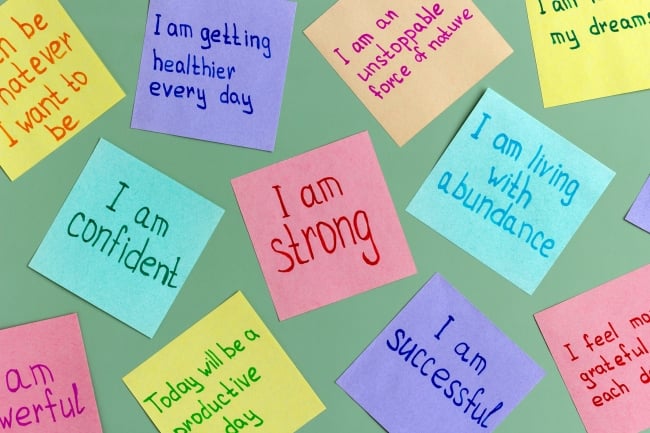You have /5 articles left.
Sign up for a free account or log in.

Affirmation stations can encourage students to practice positive thinking and self-talk.
Olena Kolisenik/iStock/Getty Images Plus
Each week, a glass windowpane in Lander University’s student union is speckled with short phrases written by students in colorful markers. The space, denoted with a large yellow sticker that reads “Bearcat Affirmation Station,” is one way the South Carolina university encourages students to share their experiences, learn from their peers and participate in campus activities.
Michael Graham, the director of first-year experience at Lander, created the station to make a physical place for students to express themselves and receive validation in their life at college, recognizing the unique lived experiences of each student in a fun and public, but still anonymous, way. Graham shared the initiative with attendees of the National Resource Center for the First-Year Experience and Students in Transition Annual Conference in Seattle.
What’s the need? An affirmation station is a technique used most often by K-12 educators to promote positive thinking and self-esteem and to support students’ mental health. However, all students can benefit from positive reframing.
Research points to the value of self-affirmation in producing self-processing and valuation activity in the brain when thinking about future experiences, and self-affirmation makes people more likely to be receptive to interventions, such as health behaviors or academic performance.
How it works: Lander’s affirmation station is actually the Plexiglas guard on the back of an elevator shaft that has been configured to serve as a whiteboard for student ideas.
Located near the cultural center and dining facilities, it’s in a highly trafficked area that is visible to students throughout the day.
Each week, first-year experience student employees (peer mentors) write a new question on the glass for students to respond to. Some of the questions have included:
- What are you most excited about for this semester?
- What is one skill you have improved in the first five weeks of the semester?
- What is one event that you have gone to this semester that you enjoyed?
- What is the biggest challenge you have overcome so far this semester?
- What is one topic from this semester you are excited to learn more about?
During the day, a peer mentor (or several) will stand next to the station with colorful markers and invite students to write their answers. To promote thoughtful and appropriate answers, students must tell the peer mentor what they plan to write before they can do so.
Peer mentors take photos of the wall and, at the end of the week, photos are shared on the first-year experience Instagram account. Staff sometimes create a word cloud to see how student responses varied or were similar.
The impact: Fall 2023 was the first semester for the Affirmation Station and, over all, it was a hit with students. On social media, the affirmation station posts were the most popular, with students recognizing their peers in the photos and sharing posts more widely.
The initiative also requires few resources—just utilization of a campus space and the time of student leaders.
Over the course of the term, staff streamlined the process and helped guide students in their responses. They also created more student leader facilitation to avoid any negative words or phrases being written on the wall. They learned that writing the question on the board helped students reflect and made the wall more meaningful as students walked by.
If your student success program has a unique feature or twist, we’d like to know about it. Click here to submit.




